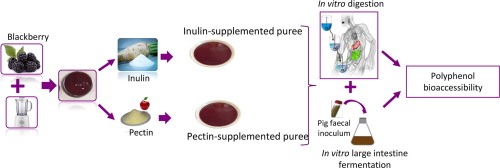Food Research International ( IF 8.1 ) Pub Date : 2019-12-26 , DOI: 10.1016/j.foodres.2019.108954 Merve Tomas , Gabriele Rocchetti , Silvia Ghisoni , Gianluca Giuberti , Esra Capanoglu , Luigi Lucini

|
The aim of this study was to investigate the modulation of polyphenols profile of blackberry purees by soluble dietary fibres (inulin or pectin), during a simulated in vitro gastrointestinal digestion and large intestine fermentation process. Untargeted profiling evidenced that the free phenolic fraction of blackberry puree was characterized mainly by flavonoids, followed by phenolic acids, lignans and other low molecular weight polyphenols, showing clear differences from the bound phenolic fraction detected. This trend could be related to the interactions of dietary fibre and polyphenols, showing synergistic and/or antagonist effect on the bioactivity of polyphenols. On the other hand, in vitro large intestine fermentation of blackberry purees following in vitro gastrointestinal digestion revealed that the highest inclusion level (10% w/w) of soluble dietary fibres was effective in modulating the bioaccessibility of some phenolic classes (mainly phenolic acids, lignans and flavones) characterizing the blackberry puree. In addition, multivariate statistics following metabolomics-based profiling showed that the interaction between fibres and blackberry purees determined a marked modification of both anthocyanins and flavonols during in vitro large intestine fermentation, thus leading to the formation of low-molecular-weight compounds (such as tyrosol, followed by gallic and benzoic acids).
中文翻译:

不同可溶性膳食纤维对体外消化和大肠发酵的黑莓原浆中酚类成分的影响
这项研究的目的是在模拟的体外胃肠消化和大肠发酵过程中,研究可溶性膳食纤维(菊粉或果胶)对黑莓泥中多酚谱的调节作用。无目标分析表明,黑莓酱中的游离酚类成分主要以类黄酮为特征,其次是酚酸,木脂素和其他低分子量多酚,与检测到的结合酚类成分存在明显差异。这种趋势可能与膳食纤维和多酚的相互作用有关,对多酚的生物活性表现出协同和/或拮抗作用。在另一方面,在体外大肠黑莓果泥的发酵以下体外胃肠道消化显示,可溶性膳食纤维的最高夹杂物含量(10%w / w)可有效调节黑莓果泥中某些酚类(主要是酚酸,木脂素和黄酮)的生物利用度。此外,基于代谢组学的分析后的多元统计数据表明,纤维与黑莓果泥之间的相互作用决定了体外大肠发酵过程中花青素和黄酮醇的显着修饰,从而导致形成低分子量化合物(例如酪醇,然后是没食子酸和苯甲酸)。



























 京公网安备 11010802027423号
京公网安备 11010802027423号